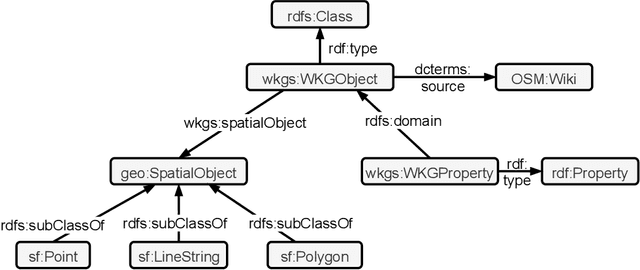Alishiba Dsouza
Creating Knowledge Graphs for Geographic Data on the Web
Feb 17, 2023Abstract:Geographic data plays an essential role in various Web, Semantic Web and machine learning applications. OpenStreetMap and knowledge graphs are critical complementary sources of geographic data on the Web. However, data veracity, the lack of integration of geographic and semantic characteristics, and incomplete representations substantially limit the data utility. Verification, enrichment and semantic representation are essential for making geographic data accessible for the Semantic Web and machine learning. This article describes recent approaches we developed to tackle these challenges.
WorldKG: A World-Scale Geographic Knowledge Graph
Sep 21, 2021



Abstract:OpenStreetMap is a rich source of openly available geographic information. However, the representation of geographic entities, e.g., buildings, mountains, and cities, within OpenStreetMap is highly heterogeneous, diverse, and incomplete. As a result, this rich data source is hardly usable for real-world applications. This paper presents WorldKG -- a new geographic knowledge graph aiming to provide a comprehensive semantic representation of geographic entities in OpenStreetMap. We describe the WorldKG knowledge graph, including its ontology that builds the semantic dataset backbone, the extraction procedure of the ontology and geographic entities from OpenStreetMap, and the methods to enhance entity annotation. We perform statistical and qualitative dataset assessment, demonstrating the large scale and high precision of the semantic geographic information in WorldKG.
Towards Neural Schema Alignment for OpenStreetMap and Knowledge Graphs
Jul 28, 2021



Abstract:OpenStreetMap (OSM) is one of the richest openly available sources of volunteered geographic information. Although OSM includes various geographical entities, their descriptions are highly heterogeneous, incomplete, and do not follow any well-defined ontology. Knowledge graphs can potentially provide valuable semantic information to enrich OSM entities. However, interlinking OSM entities with knowledge graphs is inherently difficult due to the large, heterogeneous, ambiguous, and flat OSM schema and the annotation sparsity. This paper tackles the alignment of OSM tags with the corresponding knowledge graph classes holistically by jointly considering the schema and instance layers. We propose a novel neural architecture that capitalizes upon a shared latent space for tag-to-class alignment created using linked entities in OSM and knowledge graphs. Our experiments performed to align OSM datasets for several countries with two of the most prominent openly available knowledge graphs, namely, Wikidata and DBpedia, demonstrate that the proposed approach outperforms the state-of-the-art schema alignment baselines by up to 53 percentage points in terms of F1-score. The resulting alignment facilitates new semantic annotations for over 10 million OSM entities worldwide, which is more than a 400% increase compared to the existing semantic annotations in OSM.
 Add to Chrome
Add to Chrome Add to Firefox
Add to Firefox Add to Edge
Add to Edge